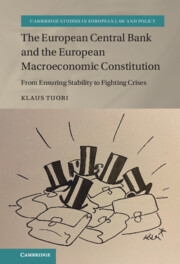 The European Central Bank and the European Macroeconomic Constitution
The European Central Bank and the European Macroeconomic Constitution Book contents
- The European Central Bank and the European Macroeconomic Constitution
- Cambridge Studies in European Law and Policy
- The European Central Bank and the European Macroeconomic Constitution
- Copyright page
- Contents
- Figures
- Series Editors’ Preface
- Preface and Acknowledgements
- Abbreviations
- 1 Introduction: A Supranational Central Bank as a Subject
- Part I The ECB as the Central Bank of the European Macroeconomic Constitution
- Part II Crises, ECB Measures and the Macroeconomic Constitution
- 5 ECB Monetary Policy during the Financial Crisis
- 6 The Prelude to the Sovereign Debt Crisis: Events, ECB Verbal Interventions and EU Rescue Programmes
- 7 Selective Government Bond Purchases
- 8 The ECB’s Quantitative Easing
- 9 The Banking Union: The ECB Takes Over Banking Supervision
- 10 ECB Measures during the Covid-19 Pandemic
- Part III The ECB from a Central Bank of Stability to a Central Bank of Crisis
- Bibliography
- Index
5 - ECB Monetary Policy during the Financial Crisis
from Part II - Crises, ECB Measures and the Macroeconomic Constitution
Published online by Cambridge University Press: 15 September 2022
- The European Central Bank and the European Macroeconomic Constitution
- Cambridge Studies in European Law and Policy
- The European Central Bank and the European Macroeconomic Constitution
- Copyright page
- Contents
- Figures
- Series Editors’ Preface
- Preface and Acknowledgements
- Abbreviations
- 1 Introduction: A Supranational Central Bank as a Subject
- Part I The ECB as the Central Bank of the European Macroeconomic Constitution
- Part II Crises, ECB Measures and the Macroeconomic Constitution
- 5 ECB Monetary Policy during the Financial Crisis
- 6 The Prelude to the Sovereign Debt Crisis: Events, ECB Verbal Interventions and EU Rescue Programmes
- 7 Selective Government Bond Purchases
- 8 The ECB’s Quantitative Easing
- 9 The Banking Union: The ECB Takes Over Banking Supervision
- 10 ECB Measures during the Covid-19 Pandemic
- Part III The ECB from a Central Bank of Stability to a Central Bank of Crisis
- Bibliography
- Index
Summary
The series of crises started with the global financial crisis that gained speed with the collapse of Lehman Brother in Autumn 2008. The ECB as any other major central bank became deeply involved in solving the crisis, which had eroded banks’ ability to trust each other. The ECB provided increasing amounts of liquidity to banks, and in many ways replaced interbank markets with its own operational framework. Other exceptional measures included easing and expanding of accepted collateral, purchases of high-quality covered bonds issued by banks. The constitutional analysis culminated on the question, whether the ECB measures can be classified as monetary policy. Generally, the provision of liquidity, even in some unusual forms, and its rationales were even classical monetary policy and similar to other central banks. The main objective was stability and sufficient liquidity in the euro area financial markets. The ECB did not give financial assistance to a Member State or their banks, and its independence was maintained. Only the later three-year LTROs could be assessed somewhat differently.
Keywords
- Type
- Chapter
- Information
- The European Central Bank and the European Macroeconomic ConstitutionFrom Ensuring Stability to Fighting Crises, pp. 129 - 149Publisher: Cambridge University PressPrint publication year: 2022
- 3
- Cited by
